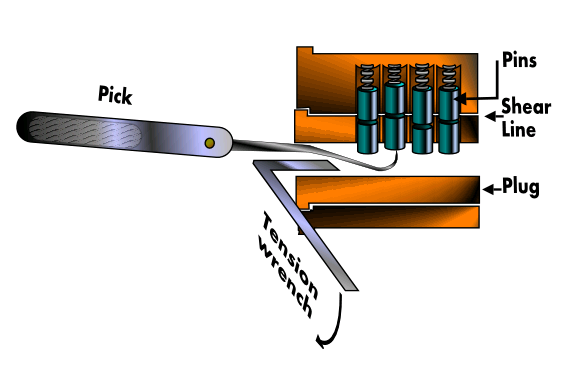How To Re-Key a Lock. How to Pick a Lock. How to Break a Kryptonite Lock
I have a bin full of keyless locks – probably a couple hundred dollars’ worth of them. One in particular, a bicycle cable lock made by Master Lock, would be perfect to help keep any potential barbeque thieves from stealing my new Weber from the side porch. Remembering how a locksmith once used just a blank key and a file to make a key for my old Land Rover’s car door, I decided to research how to create a new key for this lock. Found this video – it doesn’t look too hard… that is, if I can get the cylinder out.
Dive into the howstuffworks entry on the pin and tumbler setup, and a good overview on how lockpicking works.
The process of re-keying a lock is very simple. The locksmith removes all of the pins from the cylinder. Then, drawing from a collection of replacement pins of various sizes, the locksmith selects new lower pins that fit perfectly between the notches of the key and the shear line. This way, when you insert the new key, the lower pins will push all the upper pins just above the shear line, allowing the cylinder to turn freely. (This process may vary depending on the particular design of the lock.)
Lock-picking skills are not particularly common among burglars, mainly because there are so many other, simpler ways of breaking into a house (throwing a brick through a back window, for example). For the most part, only intruders who need to cover their tracks, such as spies and detectives, will bother to pick a lock.

So let’s assume that you’re not a burglar and you are interested in picking a lock solely for recreational purposes. A good site with plenty of basic info is the wikihow page on lockpicking. The general centerpiece is the tension wrench, an L-shaped clip that lets you put some rotational force onto the cylinder. As the pins are lined up with the picks, the tension generated by the tension wrench holds them in place, until all the pieces are lined up and the lock rotates open.
Lock picking is really all about the tension wrench. You will constantly need to find and hold just the right amount of torque to allow you to push the upper pins out of the cylinder while ensuring that pins set and stay set.
Looks easy, but from experience I an vouch that it is indeed tricky at first.
Finesse is good if you want to preserve the lock or need to remove the cylinder for rekeying. If you just need to get your bike free because you lost the key to your kryptonite down the sewer, there are a few ways to go about it. Just make sure to bring some proof of ownership so you don’t get hassled by someone thinking you’re stealing bikes. Don’t steal bikes!!!
Angle grinder:
Hydraulic car jack (this is a floor jack, although people use bottle jacks too):
Freeze it with compressed air, or use liquid nitrogen. The times I’ve experimented with using a bottle of compressed air (flip it over to spray the super-cold propellant out the nozzle), I didn’t have much luck – I don’t know for sure that it gets cold enough to truly affect a kryptonite lock. These guys show that it’s possible to do so with a small combination lock though.
What does work, however, is liquid nitrogen. Submerge the lock as best you can into the liquid until the boiling mostly stops (meaning the temperature of the lock has gotten close to that of the liquid). The metal will now be brittle enough to crack apart with a few good hits from a hammer.
